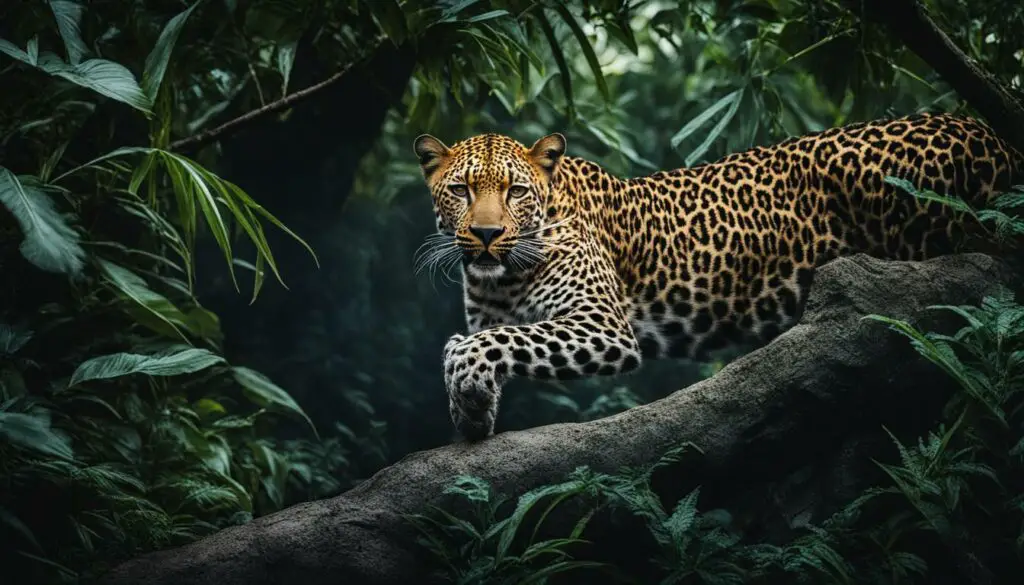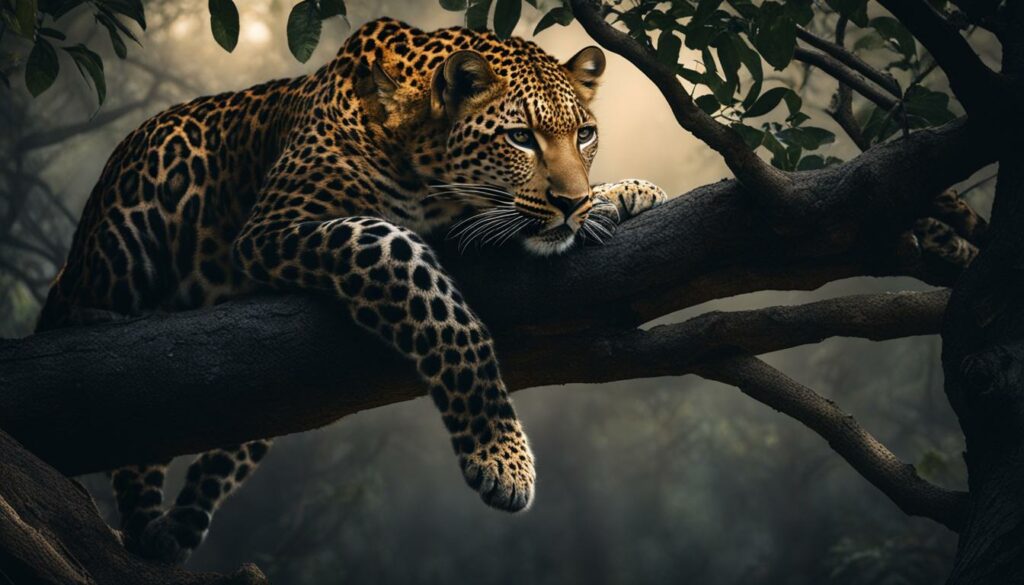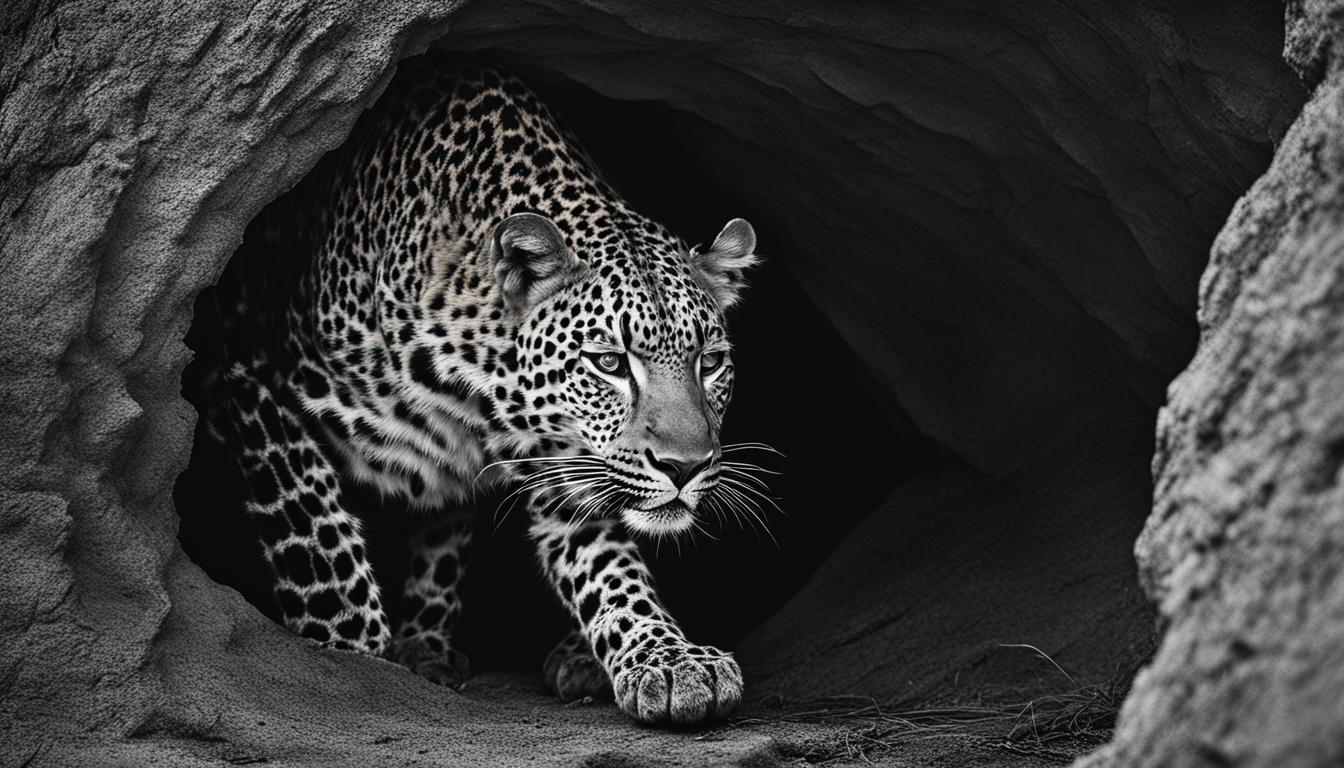Leopards are fascinating creatures known for their incredible nocturnal behavior. These magnificent big cats have evolved various adaptations to thrive in the darkness and make the most of their hunting activities. Their nocturnal habits are key to their survival and play a crucial role in their ability to hunt efficiently while avoiding competition with other predators that are active during the day.
One of the most remarkable adaptations of leopards is their excellent night vision. They possess a mirror-like layer in the back of their eyes called the Tapetum lucidum, allowing them to see six times better than humans in low light conditions. With this advantage, leopards can navigate through the darkness with ease and spot their prey from long distances. It’s truly a marvel of nature!
Leopard Diet: Adaptations
Leopards have mastered the art of survival through their remarkable adaptations, and their diet is no exception. These majestic creatures have adapted to eat a variety of animals in their habitat, ensuring a steady food supply regardless of the availability of certain prey species. Whether it’s a large antelope or a small bird, fish, or mouse, leopards can adapt their hunting strategies to secure a meal during their nocturnal activities. Their flexible diet allows them to thrive in different environments and maintain their energy levels.
With their exceptional hunting skills, leopards can take down larger prey such as antelopes, thanks to their muscular bodies and sharp claws. However, their adaptable nature also allows them to target smaller creatures when necessary. This versatility in their diet enables them to survive and thrive in a wide range of habitats, adapting to changing conditions and increasing their chances of successful hunts.
In the dark of night, leopards exhibit their stealthy nature and rely on their acute senses and adaptations to secure their next meal. Their excellent night vision, attributed to a mirror-like layer in their eyes called the Tapetum lucidum, enables them to see six times better than humans in low light conditions. This adaptation provides them with a significant advantage when hunting in the dark, allowing them to spot potential prey and stalk them undetected.
Table: Leopard Diet Adaptations
| Adaptation | Description |
|---|---|
| Flexible Diet | Leopards can consume a variety of animals, ranging from large antelopes to smaller creatures like birds, fish, and mice. |
| Muscular Body | Their muscular bodies enable them to take down larger prey and maintain their strength during hunts. |
| Sharp Claws | Leopards have sharp claws that aid in capturing and holding onto their prey. |
| Night Vision | The mirror-like layer in their eyes, the Tapetum lucidum, enhances their night vision, allowing them to see in low light conditions. |
Leopards’ ability to adapt their diet to the available resources in their habitat is a testament to their resilience and survival instincts. Whether it’s a swift antelope or a small and elusive mouse, leopards have honed their hunting skills to maintain a balanced and sustainable diet. Their adaptability ensures their status as apex predators and reinforces their position as masters of the night.
Leopard Habitat: Adaptations
Leopards, as skilled hunters, have numerous adaptations that aid in their successful capture of prey. One notable adaptation is their choice of sleeping habitats. Leopards are known to sleep in trees during the day, utilizing their agility and muscular bodies to ascend to safe vantage points. This behavior allows them to observe their surroundings and avoid potential threats, ensuring their survival.
Leopards’ hunting behavior is also shaped by their habitat adaptations. With their muscular and sleek bodies, they possess incredible agility and speed, making them formidable predators. Their large heads and powerful jaws, accompanied by sharp canine teeth and retractable claws, enable them to efficiently attack and subdue their prey. These physical adaptations contribute to their hunting success in the dark.
Furthermore, leopards exhibit innate behavioral adaptations that enhance their survival during their nocturnal hunts. Camouflage is one such adaptation, as leopards can effectively blend with their surroundings, remaining undetected by both prey and potential predators. This ability to remain hidden grants them an advantage when stalking close to their unsuspecting prey. Their preference for hunting at night also minimizes encounters with other competing predators, ensuring a higher success rate in capturing prey.
Hunting and Sleeping Patterns of Leopards
“Leopards have evolved remarkable adaptations to thrive in their nocturnal hunting activities. Their agile bodies, keen senses, and ability to camouflage themselves in the darkness make them one of the most efficient predators in the animal kingdom.”
Understanding the hunting and sleeping patterns of leopards provides valuable insights into their remarkable ability to adapt and survive in the dark. Whether it’s their choice of sleeping habitats, physical attributes, or behavioral tendencies, these adaptations work together to ensure their hunting prowess and overall survival in their respective environments.

| Leopard Habitat Adaptations | Description |
|---|---|
| Tree Sleeping | Leopards sleep in trees during the day to observe their surroundings and avoid potential threats. |
| Muscular and Agile Bodies | Leopards have sleek bodies that allow them to move swiftly and silently, essential for stalking and ambushing prey in low light conditions. |
| Powerful Jaws and Claws | Their large heads, sharp teeth, and retractable claws enable leopards to attack and subdue their prey effectively. |
| Camouflage | Leopards blend into their surroundings, remaining undetected by both prey and potential predators. |
| Nocturnal Hunting | Leopards prefer to hunt at night, reducing the risk of encountering competing predators and increasing their chances of successful hunts. |
Physical Adaptations of Leopards
Leopards have evolved a range of physical adaptations that enable them to excel in their nighttime hunting activities. These adaptations have shaped their bodies to navigate through the darkness and effectively capture their prey. Here are some key physical adaptations of leopards:
1. Sensitive Whiskers
Leopards possess long and highly sensitive whiskers, known as vibrissae, which help them navigate and detect objects in low light conditions. These whiskers act as tactile sensors, allowing leopards to determine the nearby presence of obstacles, prey, or potential threats.
2. Retractable Claws
Leopards have retractable claws that stay hidden within their paws when not in use. This adaptation helps keep their claws sharp and protected from wear and tear. When hunting or climbing, leopards extend their claws, providing them with extra grip and allowing them to silently approach their prey or ascend trees with ease.
3. Enhanced Night Vision
Leopards possess a specialized structure in their eyes called the Tapetum lucidum, which reflects light and boosts their night vision capabilities. This adaptation enhances their ability to see in the dark and provides them with a distinct advantage over their prey. With their exceptional night vision, leopards can spot and stalk their prey even in the dimmest moonlight.
| Physical Adaptations | Description |
|---|---|
| Sensitive Whiskers | Long and highly sensitive whiskers that act as tactile sensors. |
| Retractable Claws | Claws that can be extended for hunting and climbing. |
| Enhanced Night Vision | Specialized structure in their eyes for improved night vision. |
These physical adaptations, among others, have allowed leopards to master the art of hunting in the dark. Their bodies are finely tuned to navigate through the darkness, silently stalk their prey, and ensure their survival in their nocturnal domain.
Leopards have developed a range of physical adaptations that enable them to excel in their nighttime hunting activities.
Behavioral Adaptations of Leopards
Leopards have developed various behavioral adaptations to enhance their survival and hunting abilities at night. One of their key strategies is camouflage. They blend seamlessly into their surroundings, using their spotted fur to hide among the shadows, making it difficult for their prey to detect them. This stealthy behavior allows leopards to get closer to their targets without being noticed, increasing their chances of a successful hunt.
Another behavioral adaptation of leopards is their flexible diet. They are opportunistic predators and can adjust their food choices based on the availability of prey species in their habitat. This adaptability ensures that leopards can find sustenance even when their preferred prey is scarce. By diversifying their diet, leopards maximize their chances of survival in different environments.
Leopards also display nocturnal hunting behavior, preferring to hunt during the night. This behavior reduces competition with other predators that are active during the day, allowing leopards to have a greater chance of securing their prey. Furthermore, hunting at night takes advantage of their exceptional night vision, giving them a significant advantage over their prey. Leopards have a mirror-like layer called the Tapetum lucidum in the back of their eyes, which enhances their ability to see in low light conditions.

Nocturnal Characteristics of Leopards
Leopards exhibit several characteristics that make them well-suited for nocturnal activities. Their eyes, with the specialized Tapetum lucidum, allow them to see up to six times better than humans in the dark, giving them a distinct advantage when hunting at night. Their keen senses and ability to maneuver stealthily in the dark make them efficient hunters, often ambushing their unsuspecting prey with precision.
During the day, leopards rest in the safety of trees. This behavior not only provides them with a vantage point to observe their surroundings, but it also helps them avoid potential threats on the ground. Sleeping in trees allows leopards to conserve energy and remain hidden from other predators, ensuring their survival in a competitive ecosystem.
In conclusion, leopards have developed remarkable behavioral adaptations that enable them to thrive in their nocturnal hunting activities. From their superior camouflage and flexible diet to their preference for hunting at night and their ability to sleep in trees, these adaptations equip them with the necessary skills to survive in diverse environments. Understanding the behavioral characteristics of leopards sheds light on their fascinating ability to adapt and succeed in the dark realm of the nighttime jungle.
Survival Adaptations of the Amur Leopard
The Amur leopard, a subspecies of leopard, has developed a range of survival adaptations that enable it to thrive in its unique habitat. These adaptations include physical characteristics and behaviors that allow the Amur leopard to navigate the challenges it faces in its environment.
One significant adaptation of the Amur leopard is its sleeping patterns. Like other leopards, the Amur leopard is primarily nocturnal, hunting and being active during the night. This behavior helps it avoid competition with other predators and increases its chances of successful hunts. During the day, the Amur leopard sleeps in trees, providing a safe vantage point to observe its surroundings and evade potential threats.
“The Amur leopard is an excellent climber, with strong claws and muscular legs, allowing it to ascend trees to rest and hide prey from other predators.”
In addition to its sleeping patterns, the Amur leopard has physical adaptations that aid in its survival at nighttime. Its coat changes with the seasons, growing thicker in winter to withstand the cold and thinner in summer to cope with the heat. This adaptability allows the Amur leopard to thrive in its harsh environment.
Overall, the Amur leopard’s survival adaptations, including its sleeping patterns and physical characteristics, contribute to its ability to endure and flourish in its habitat. By understanding these adaptations, we gain insights into the remarkable capabilities of this subspecies and the importance of conserving its population.
Table: Physical and Behavioral Adaptations of the Amur Leopard
| Adaptations | Description |
|---|---|
| Nocturnal Behavior | The Amur leopard hunts and is active during the night, reducing competition with diurnal predators. |
| Tree Sleeping | The Amur leopard sleeps in trees during the day, providing a safe vantage point to observe its surroundings and avoid threats. |
| Coat Adaptation | The Amur leopard’s coat changes with the seasons, growing thicker in winter to withstand the cold and thinner in summer to cope with the heat. |
| Climbing Ability | The Amur leopard is an excellent climber, with strong claws and muscular legs, allowing it to ascend trees to rest and hide prey from other predators. |
Breeding and Physical Characteristics of Leopards
Leopards possess unique physical characteristics that contribute to their survival and success as predators. Adult male leopards can weigh between 80-160 pounds, while adult females typically weigh between 60-120 pounds. Their muscular bodies, sharp claws, and powerful jaws make them skilled hunters, capable of taking down a variety of prey. Leopards are also adept climbers, using their sharp claws and strong limbs to navigate trees with ease. Additionally, they are strong swimmers, enabling them to cross rivers and pursue prey in aquatic environments.
In terms of reproduction, female leopards have a pregnancy cycle of approximately three and a half months. They typically give birth to one to six cubs, which they nurture and protect until they gain independence at around two years of age. Female leopards are devoted mothers, providing food, shelter, and guidance to their young. The reproductive abilities of leopards contribute to the growth and sustainability of their populations in various habitats.
To provide a visual summary of the physical characteristics of leopards, here is a table:
| Physical Characteristics | Details |
|---|---|
| Weight | Adult males: 80-160 pounds Adult females: 60-120 pounds |
| Hunting Adaptations | Muscular bodies, sharp claws, powerful jaws |
| Climbing Abilities | Sharp claws, strong limbs |
| Swimming Skills | Capable of crossing rivers and hunting in aquatic environments |
Understanding the breeding and physical characteristics of leopards provides valuable insights into their ability to adapt and survive in diverse habitats. These traits, combined with their behavioral and ecological adaptations, make leopards formidable apex predators that play a crucial role in maintaining the balance of ecosystems they inhabit.
Conclusion
Leopards are fascinating creatures with remarkable adaptations that allow them to excel in their nocturnal hunting activities. Their ability to hunt and thrive in the darkness is a testament to their physical and behavioral traits.
With their powerful bodies, sharp teeth and claws, and excellent night vision, leopards have evolved to become apex predators in their habitats. Their long legs and agile movements enable them to silently stalk and ambush their prey, while their camouflaging skills help them blend seamlessly into their surroundings.
Leopards’ preference for hunting at night reduces the risk of competition with other predators, increasing their chances of successful hunts. Their flexible diet and ability to adjust their food choices based on prey availability further contribute to their survival.
In the heart of darkness, leopards have mastered the art of nocturnal behavior. Their remarkable adaptations and innate instincts have allowed them to thrive and maintain their populations in a wide range of environments. By understanding their behavior in the dark, we gain a deeper appreciation for these incredible creatures and their ability to adapt and survive.
Do Leopards and Cheetahs Have Similar Techniques for Nighttime Hunting?
Leopards and cheetahs hunting at night may have differences in their techniques. Leopards use their keen night vision to silently stalk and ambush prey, while cheetahs rely on their speed to chase down prey in the darkness. Their different hunting strategies reflect their unique adaptations to nocturnal environments.
FAQ
How do leopards adapt to hunting at night?
Leopards are nocturnal creatures, meaning they are awake and actively hunting at night. They have excellent night vision, thanks to a mirror-like layer in the back of their eyes called the Tapetum lucidum, which helps them see six times better than humans in low light conditions.
What do leopards eat?
Leopards have a flexible diet and can consume large antelopes as well as smaller creatures like birds, fish, mice, and more. This adaptation allows them to always have enough food to eat, even when certain prey species become scarce.
What are the physical adaptations of leopards for hunting?
Leopards have muscular and sleek bodies that make them fast and agile. They also have large heads and jaws, sharp canine teeth, and sharp claws, which enable them to attack and subdue their prey effectively.
What are the physical adaptations of leopards for surviving at night?
Leopards have long legs that allow them to move swiftly and silently in low light conditions. They also have long, flexible tails for maintaining balance while climbing trees and running. Their hooked claws and sharp teeth are used to pierce and weaken their prey.
What are the behavioral adaptations of leopards for surviving at night?
Leopards have learned to camouflage themselves effectively, using their surroundings to hide and remain undetected by both prey and potential predators. They also exhibit a flexible diet, adjusting their food choices based on the availability of prey species. Additionally, leopards prefer to hunt at night, reducing the risk of encountering competing predators and increasing their chances of successful hunts.
What are the survival adaptations of the Amur Leopard?
The Amur leopard possesses a coat that changes with the weather, with thick fur in winter to withstand the cold and a thin coat in summer to cope with the heat. It also has long legs that enable it to navigate deep snow, and it is an excellent climber, with strong claws and muscular legs.
How do leopards reproduce and what are their physical characteristics?
Female leopards have a pregnancy cycle of approximately three and a half months and typically give birth to one to six cubs. Adult male leopards can weigh between 80-160 pounds, while adult females can weigh between 60-120 pounds. They are skilled hunters, adept climbers, and strong swimmers.










